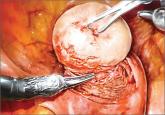From the Editor

Benefits and pitfalls of open power morcellation of uterine fibroids
The current practice of open power morcellation is being scrutinized by those within and outside of the ObGyn community. We need to re-examine our...
Robert L. Barbieri, MD
Editor in Chief
Chair, Obstetrics and Gynecology, Brigham and Women’s Hospital, Boston, Massachusetts; Kate Macy Ladd Professor of Obstetrics, Gynecology and Reproductive Biology, Harvard Medical School, Boston
rbarbieri@frontlinemedcom.com
Dr. Barbieri reports no financial relationships relevant to this article.

The bag is opened and two Heaney retractors are placed in the vagina at 6 o’clock and 12 o’clock positions to protect the vaginal tissue, urethra, bladder, and rectum. Lahey clamps are placed on the uterine cervix and the uterus is morcellated using a cold-knife. Favero and colleagues prefer to bivalve a small uterus to facilitate its removal through the vagina. Coring of the uterus may be preferred for very large uterine tumors.
Technical difficulties. Techniques that use morcellation in a bag are currently plagued by a number of technical difficulties. It can be very difficult to place a large tumor in a floppy bag. Advances in bag technology that use a more rigid bag opening likely will help to overcome this difficult step. Pulling the bag up through a port site or cannula requires an incision in the range of 30 mm—larger than the incision currently employed in many laparoscopic operations. The larger incision is likely associated with more pain and greater time to full postoperative recovery.
VAGINAL HYSTERECTOMY AND CORING OF TISSUE OUTSIDE OF A BAG
Vaginal hysterectomy, when surgically feasible, is the most cost-effective approach to hysterectomy.10 Standard vaginal hysterectomy removes the uterus in its entirety without significantly disrupting the uterine serosa. When the uterus is too large for a standard approach, vaginal coring using a scalpel is often utilized (VIDEO 2).11
Kho and colleagues have reported that the transvaginal placement of an Alexis retractor (Applied Medical, Rancho Santa Margarita, California) can facilitate the process of vaginal coring.12 Coring or bivalving the large uterus has a small risk of spreading small bits of tissue into the vagina and near the vaginal apex. From my perspective, this risk is much less than the risk of open power morcellation of a uterine tumor because the uterine serosa is pulled tightly against the vagina, reducing the spread of tissue into the peritoneal cavity.
MINI-LAPAROTOMY
After laparoscopic hysterectomy or myomectomy, a mini-laparotomy can be made and the uterus or uterine tumor can be pulled up to the skin surface and removed by coring the tissue with a scalpel.13 Similar to vaginal coring, although the process does not occur in a bag, the risk of spreading tumor tissue into the abdominal cavity is reduced compared with open power morcellation. However, using this technique, tissue may be spread into the abdominal incision resulting in the postoperative growth of small nodules of endometrium or fibroids in the incision.
ABDOMINAL HYSTERECTOMY AND MYOMECTOMY
Abdominal hysterectomy and myomectomy are very safe approaches for the intact removal of the uterus, uterine tumors, and myomas. The main disadvantage of these approaches is the need for incisions that are much larger than those used for laparoscopic surgery and the resulting increased risk for surgical site infection, postoperative pain, and prolonged recovery.
Related Article: Tips and techniques for robot-assisted laparoscopic myomectomy Arnold P. Advincula, MD (August 2013)
OBSTETRICIANS-GYNECOLOGISTS—INNOVATORS AND PROBLEM SOLVERS
Open power morcellation has significantly advanced gynecologic surgery, permitting the removal of large tumors through small incisions, thereby enhancing patient outcomes. Open power morcellation has a significant flaw because tumor tissue can spread around the abdominal cavity resulting in the postoperative growth of tumor nodules on peritoneal surfaces. Gynecologists are working hard to develop innovative solutions to this problem. Technology that has been patented and is in the process of commercialization will help to solve the problem created by open power morcellation.14–16
One novel technology that is being developed is an actuated “wire” mesh power morcellation system that is performed in a bag.17 This technique uses a net of “wire” mesh to slice the tumor into small cubes within a bag. The small cubes can then be removed through a standard laparoscopy port.
Inventions that advance the ability to perform power morcellation in a bag will significantly advance the field of gynecology. While we wait for US Food and Drug Administration approval of these new technologies, gynecologists should reduce their use of open power morcellation to remove large uterine tumors thought to be fibroids. Alternative surgical approaches are available to remove large uterine tumors without risking the spreading of small tumor morsels throughout the abdominal cavity.
INSTANT POLL
How are you reducing your use of open power morcellation? What are your experiences?
Tell us! Send a Letter to the Editor to rbarbieri@frontlinemedcom.com. Please include your name and city and state.

The current practice of open power morcellation is being scrutinized by those within and outside of the ObGyn community. We need to re-examine our...

Three intraoperative videos show surgical techniques from Javier F. Magrina, MD, and John B. Gebhart, MD, regarding morcellomas, and the vaginal...
New data and the guidance of our professional societies are bringing us closer to clarity in understanding the superiority of minimally invasive...

With robotic assistance, a surgeon can reduce blood loss, shorten hospitalization, and ease laparoscopic suturing and knot-tying—but myomectomy is...
This technique is K. Anthony Shibley, MD's, short-term surgical solution to performing closed power morcellation. His patented pneumoperitoneum...

Perform morcellation through a 5-mm laparoscope with the robot undocked, using the camera port site for morcellation.
The multiple advantages a laparoscopic approach to myomectomy can offer over laparotomy hinge on surgical technique—from preoperative evaluation...
